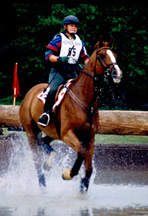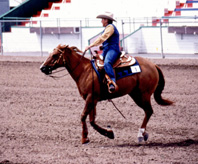 |
Mirror KB Articles
|
 |
Mirror KB Articles
|
Mirror KB Equine Article Series
Conditioning for Maximum Performance
Article and Photos by Kim and Kari Baker

As a owner, the all important question you must ask yourself is what event your horse is physically and mentally suited for. Is the horse built to easily breeze his way to the winners circle on the race track or possibly to cover mile upon mile of rugged terrain vying for the top honor of best conditioned distance horse? However, maybe he is better suited to cutting out and handily work a cow in one of the popular cattle events or making a long sliding stop as a reining horse . To answer this question the you must also determine if the top performance of your horse will demand only speed or if it will require a combination of speed and skill to expertly execute the chosen sport? And then, not only must the physical requirements be weighed, so must the mental and emotional aspects of performing the given task be taken into consideration.
Once youíve settled on which event to pursue with your equine athlete youíre now faced with the job of creating an individualized training program. This program, tagged by the professional fitness trainer as progressive loading or precision training, is best known simply as conditioning. In order to build such a program with any real success, you must first have a little understanding of equine physiology.
Training programs are formed around three basic stages, the initial stage, the developmental stage, and the maintenance stage. How long it will take to get the horse in peak condition will, without a doubt, depend on the individualís age, his genetic makeup, and the particular event the horse will be conditioned for.
Stages of Conditioning
Considered the most important of the three stages of training, every horse, no matter what sport he will eventually be performing in, should begin his training with long slow distance (LSD), for it provides the basic groundwork for all equine events. LSD is the gradual introduction of the horse to increasingly greater distances of physical exertion and over a broad variety of terrain. Here your objective will be to carefully work your horse up to an hour of exercise at a walk and trot at an average speed of 4 to 5 mph and a canter at a moderate speed of 10 to 12 mph. During this phase of conditioning, the horseís cardiovascular system is strengthened, boosting the capacity of the lungs and heart to carry and utilize oxygen. It will also increase the durability and elasticity of the muscoskeletal system. The principal advantage to all this, is that it will groom the athlete for the next stage of training, there by decreasing the chance of injury.
Moving on to the second level of conditioning, you must begin to focus on drills which mimic the moves that are essential for the particular sport your horse will be expected to execute during competition. This step in the conditioning program is essential for providing an increase in coordination, balance, and skill. At first these drills will be performed at half the rate of speed than that which is expended in the actual event, avoiding the physical and mental demands associated with competition. However, once the horse has gained sufficient skill and coordination youíll begin to put your horse through strenuous workouts, which will target the further development of precise muscle groups.
Putting it into Practice
The traditional training program used by most trainers generally centers on a five day week. Horses are ridden at an aerobic level of work on days 1 and 5 while on days 2, 3 and 4 an additional 20 minutes of a more intense exercise is added to the regular workout in order to elicit an anaerobic level of physical exertion.
Interval training, a newer approach to conditioning, consists of a 6 day week and was structured to apply the precept of "overload," which is to exercise the horse to the point bordering on fatigue. Just as in traditional training, interval training puts the horse through an aerobic exercise on days 1 and 4 followed by an intense workout, "overload" on days 2 and 5 while on days 3 and 6 the horses are only ridden at a jog for 20 minutes.
During the intense workouts on days 2 and 5 the horse is closely monitored while he repeatedly performs anaerobic exercises. The workout is ended just as the heart rate elevates over previously recorded repetitions at which point the horse is considered to be on the verge of fatigue.
How the horse responds both physically and mentally to training, no matter which method the trainer chooses to follow, will determine whether his workload should be increased, decreased, or held steady. So how will you know when he can move on to the next phase in training? In order to do this, you must pay close attention to your horseís heart rate or pulse. You should know your horseís normal resting pulse and be aware of the length of time it takes for your horse to recover a normal pulse rate following exercise. As a rule the equine athlete is ready to move on when he has a solid heart rate recovery within 5 to 15 minutes following an hour of steady exertion or when he can maintain a heart rate of under 150 beats per minute during a long gallop. Another favorable signal will be the change in the consistency of sweat from the previously thick sticky quality to a thin watery one.
As the trainer, you must be able to recognize stress and fatigue. If following a daily workout the horseís pulse recovery rate is longer than 15 minutes the horse has been faced with too great a challenge and should be brought back down to a lower level of exercise. If, at any time, there is a sudden increase in the pulse rate it may suggest that the horse is in pain and that he should first be checked for injuries before further training continues. Other signals of over stress that you can watch for include changes in gaits, dullness in attitude, irritability, weight loss, a decrease in appetite and lower leg edema.

Once the horse has acquired the desired amount of conditioning, how can you keep him at his peak throughout the entire show season? While a few horses may train for a single competition where one all out effort is required, most horses face several competitive performances during the show season. Unfortunately itís impossible to keep the equine athlete at his utmost peak condition for the entire length of the season, but by using a system of "mini peaks" you should be able to maintain your mount close to his peak condition throughout the season. This takes careful planning in order to time the athleteís peak performance to coincide with that of planned competitions.
Most successful trainers find that bringing their horses to or just under 98% of their peak then tapering the duration of exercise by half will maintain the horse in competitive condition. Just prior to the event the equine athlete may be rested in order to allow the horseís system to cleans itself of toxins and sufficiently replenish fuel shortages in preparation for the up coming competition. Following competition the horse should be allowed time to recuperate then again be brought back into a routine of exercise, bringing him back to near peak condition and a holding pattern, in preparation of the next competitive event. Barring any unexpected problems, it should be noted that for any amount of time given for rest it will require an equal amount of time in reconditioning the horse for competition.
Mental preparation of the equine athlete is just as important as his physical development and should be tailored to every conditioning program. The mood or attitude of the horse can be an effective gauge as to how the horse is adjusting to all levels of his training. Stress, while under saddle, can be observed by excessive swishing or ringing of the tail, pinned back ears, and tossing or shaking of the head. In addition, a horse that is ordinarily very sociable may become hard to catch and halter.
A sour or sullen horse might also signal that he is experiencing discomfort of some kind, a cue that his body hasnít adapted well to the demands being made on it. This may also be a sign that your horse has developed gastric ulcers. Along with poor feeding practices, the stress of training has been proven to be a major factor in the development of equine gastric ulcers in the performance horse.
It is vital that the equine athlete be evaluated as an individual and at many levels. Not only must the trainer be able to produce a physically fit athlete, he must also produce one that is psychologically tolerant. If you are to expect to compete throughout the show season with an eager mount, one that is ready and willing to meet the enormous challenges of competition, you must incorporate a well thought out conditioning program, which will fully prepare your horse for his maximum performance.
If you'd like to read more interesting articles click on the following drop down link:
|
Mirror KB Photography & Gifts 1132 Arabian Lane Libby, MT 59923-7982 |
Phone: (406) 293-6586 |
Got questions? Contact us at: wranglers@mirrorkbranch.com
Trailhead | About
Us
| On the Trail | Raising an Orphan Filly
| Tales of the Twin Wranglers
Gallery 1 | Gallery
2 | Gallery 3 | Gallery
4 | Gallery 5
Montana T-shirts and more | Clothes an' more with Robert Fuller
Design
your own | Product
Information
Training Philosophy | Photography
| Promotional Photography
Gallery 6 | Gallery
7 | Gallery 8
| Gallery 9 | Gallery
10 | Gallery 11
Just Text Horse T-shirts | Just Text Mule T-shirts
Equine Articles | Twin
Wranglers | Ol' Bake
Equine
Hangman | Product
Order Form | Links
Our
Privacy Policy
Send an
E-greeting | order Greeting Cards